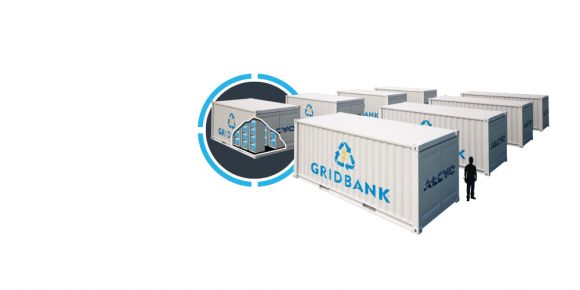From out of nowhere, a startup named Alevo has emerged as a serious rival to Tesla in the race to achieve next-generation grid battery manufacturing at gigawatt scale.
On Monday, the North Carolina-based, European-backed company announced plans to invest $1 billion in turning an old Philip Morris cigarette factory into a battery factory eventually capable of churning out "several gigawatts" per year, CEO Jostein Eikeland told me in an interview. Utility customers in North America are soon to be announced, and the company has already booked about 200 megawatts of orders, enough to fill the factory’s planned production next year, he said.
Alevo says its lithium-iron-phosphate (LiFePO4) batteries are the first to use an inorganic electrolyte based on sulfur, which prevents the chemical reactions that lead to heating, expansion and eventual failure for lithium-ion batteries. Test cells have lasted more than 40,000 cycles in “hammer tests” that completely discharge and then overcharge them over and over again, without significant degradation of performance, he said.
They won’t be for sale, however -- not exactly. Instead, the company plans to package them up into its 2-megawatt, 1 megawatt-hour GridBank containerized energy storage systems and make them available as a turnkey contractor and ongoing operator of energy storage sites and farms, he said. That could be as contractors of government or private utilities, or as market participants, he added.
In that way, the startup is competing against the grid storage arms of energy giants like AES Energy Storage, NRG Energy and Duke Energy, or networked battery offerings from the likes of Panasonic and NEC/A123. “Why not create an ecosystem, like we do with the internet or with data centers, but for storage?” Eikeland said. “Why don’t we tap that energy that’s otherwise wasted and inject it into the market?”
A breakthrough in battery lifespan through inorganic chemistry?
Eikeland, an early internet entrepreneur, coined the term "application service provider," or ASP, in 1996, and thus could be considered one of the earliest promoters of cloud computing. He’s since invested in software and IT startups, as well as magnesium die casting and other high-tech manufacturing -- and, since 2004, battery startups. Alevo got started back then as an effort to coordinate R&D at various portfolio companies, he said.
“We were invested in Germany in the U.K. and we have some Chinese investments. They all had good things, but collectively they didn’t have the right thing,” he said. The right thing, in this case, was a battery that can run 24 hours a day, 7 days a week, for up to twenty years, without losing its efficacy or putting itself under stress that could lead to breakdown or worse.
That led to its research into electrolytes that replace the organic compounds used in the vast majority of today’s lithium-ion batteries, he said. Organic materials are responsible for the chemical reactions that lead to performance degradation, as well as heat that has to be finely controlled at additional cost and complexity, lest the device burst into flame.
Alevo uses sulfur in an inorganic electrolyte, which it’s now producing in Switzerland, he said. “Nobody else has an inorganic electrolyte that we know of,” he said. “Our electrolyte can take 100 times more current draw before undergoing reactions,” compared to organic lithium-ion batteries, and “the voltage is still there, even after 40,000 cycles on the grid,” according to cell-level tests started in early 2011, Eikeland added.
Alevo also uses graphite as its active material, and nickel foam structure to maintain high ionic conductivity for the relatively greater thickness of its electrodes, and to keep internal resistance fairly constant over its lifecycle, according to the company. “The battery we have is an ugly beast; it wouldn’t win any beauty contests,” he said. “But it’s robust. And we have no active cooling -- [it just sits] at room temperature.” Safety is a critical issue for utilities, and fires and explosions have caused big problems for several grid-scale energy storage projects in the past.

All of this adds up to upfront costs on a per-kilowatt and kilowatt-hour basis that should be competitive with lithium-ion prices, as well as lifetime system costs that are 70 percent to 90 percent lower than the competition, he said. Alevo has lined up the chemicals and materials suppliers to meet its production goals, and it's also lining up the customers for its energy-storage-as-a-service offering, he said. Local news reports note that Victory Industrial Park Inc., a North Carolina corporation formed last year and associated with Alevo, paid $68.5 million for the Philip Morris site. Eventual investment in the factory will reach about $1 billion, Eikeland said.
Building the software and data platform to manage batteries at grid scale
Alevo has also done a lot of work on the software and data side of grid-scale energy storage, starting with its early attempts to clarify what utilities and other parties needed from an energy storage provider, he said.
“Utilities are very private about how they operate their systems,” Eikeland said. “It took a few years to get the data -- and then we had the problem that the data set was too big to be consumed, for us to make sense of it. […] We ended up looking at how we can run larger data sets in RAM, in memory, on a suite of hundreds or thousands of centers, each with a kernel, that all can run as one system,” he said.
Alevo has invested about $100 million into the IT side of its business, he said, to develop a simulation and modeling engine that can run multitudes of scenarios against real utility data. The goal is to find where energy storage can be cost-effectively deployed, and how its value can be captured across multiple revenue streams, at a level of accuracy that can satisfy financial backers, he said.
The company has worked with parties like the Western Electricity Coordinating Council, the group that manages the pan-Western U.S. transmission grid, to prove out its capabilities. Alevo was able to compress a data retrieval and analysis process that took about 36 hours per simulation at first, down to about ten minutes per session, he said. “What we learned from doing this very heavy, systemic simulation,” he said, “was that we were grid ready at utility scale,” he said.
Alevo plans to go to market in three ways, he said. First, it’s working with government entities and state-owned utilities, including the partnerships it announced Monday with China-ZK, a 51% privately funded body that coordinates energy infrastructure in China, and a distribution partnership with Turkish firm RBM. Eikeland told me the company’s batteries are set to be certified for use in China later this year.
“The second model is to enter commercial markets,” like mid-Atlantic grid operator PJM’s frequency regulation market, which already has more than 1 gigawatt of battery systems participating. “The third model is with individual utilities, especially here in the United states, to see how we can rate storage as a utility asset,” he said. While he didn’t name the utilities Alevo might be working with, “they’re providing their data sets, and we’re running scenarios. […] We’re pleased with what we’ve seen so far.”
Alevo will have lots of competition on the energy storage software and integration fronts. We’ve been covering the spread of software to manage batteries behind the meter (Stem, GELI, Green Charge Networks, Coda Energy, SolarCity), as well as to manage them from the utility perspective, such as Greensmith, Younicos-Xtreme Power, A123-NEC and AES Energy Storage.
Alevo has shunned government grants and venture capital investment, raising its estimated startup investment of more than $1 billion through private investments and equity funds, Eikeland said. “We had something that looked so different, and we didn’t want to be in that hype cycle,” he said.
Beyond the giant Asian lithium-ion battery manufacturers, Alevo will also be competing with Tesla Motors, which is planning to spend $5 billion to build its Giga factory in Nevada. Tesla wants to be producing about 50 gigawatts of lithium-ion batteries by 2017, and while most of those are destined for its electric vehicle fleet, it’s also targeting about 15 gigawatts toward stationary energy storage.



